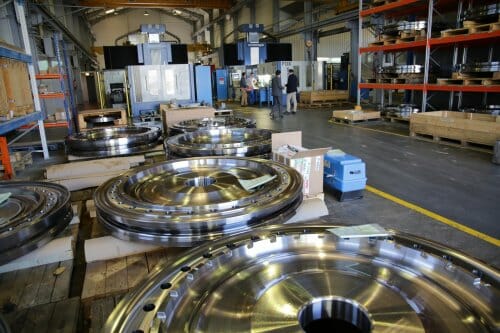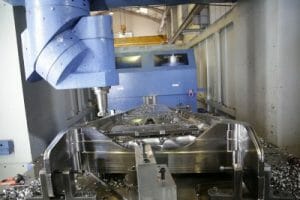Machinery selected by this subcontractor active in the fields of aeronautics and defence is subjected to extremely demanding tests. The Spanish manufacturer surpassed the established requirements.The investment generated an increase in the order portfolio
Set up in 1949 by Robert Destic for the design of tools and special machinery, Sermati has since become a tier 1 and 2 supplier for the aeronautical, defence and energy sectors under the leadership of the third generation of entrepreneurs. Xavier Mielvaque and his wife Karine Mielvaque, granddaughter of the founder, share the responsibilities of the CEO. Together they steered the company (210 staff, turnover 30 million)
towards the manufacture of high-added value parts, conserving all know-how from tool manufacturing and complex mechatronic systems. As many as 70 staff, counting external staff in two 8-hour shifts, work in the project department with a truly proactive approach. Since 2005, the focus on co-design and manufacture of titanium, inconel and refractory steel parts and subassemblies, but also of aluminium for specific markets has allowed a strong growth. This of course requires constant investments (2 million € a year on average) in top quality machines and tools. The dimensions of the parts, from 1,000 mm to 4, 000 mm, and even 10,000 mm, precision and hardness of the machined material do not allow to make any erroneous investments. Mikael Helloco, purchase manager with a highly technical profile shares his methods with us.

A complex part for the aerospace sector in the course of being machined on the Fox centre. In the box, the milling cutter used for the machining tests during the machine selection shows the extent of chip removal capabilities.
Good performance during roughing and precision for finishing
The first goal is to find gantry vertical milling machines capable of machining 80% of engine parts and structures. We had to find a good balance between efficiency and precision to ensure impeccable quality at reduced cost. “For the manufacture of complex parts made of hard and light metals with a high stock removal rate, our machines have to ensure high stiffness during roughing operations and good dynamics and precision during finishing operations” explains Mickael Helloco. After selecting the manufacturers who offered large-sized machining centres that combine power, torque, high speed, dynamics of axles and NC, it was decided to submit these machines to a machining test according to technical specifications. These were carried out at the workshops of the manufacturers in presence of the Sermati technical service and consisted of machining of titanium.
These tests showed that the Spanish manufacturer Correa scored well above the required levels. The condition of the test was to perform a 25 mm chatter-free stroke using an end mill while the ram was fully extended. The Fox machining centre managed to reach 60 mm. “When we did the test, we were surprised ourselves,” said Juan Martín, sales manager of the Correa Group. It must be said that the 3-axis UAD machining head of the Fox machining centre develops 52 kW (S1-100%) of power with a torque (S1-100%) of 1300 nm and 6,000 r.p.m. This is further complemented with a 5-axis UGV milling head rotating at 12,000 rpm generating 35 kW with 190 Nm at (S1-100%). Available for automatic loading straight from the adjacent magazine, the two heads fulfil this complementary role to ensure both roughing with major chip formation on the most difficult materials, and finishing of complex shapes with the highest possible precision.
 Fox, rigid and damped milling centre
Fox, rigid and damped milling centre
The Fox machining centre combines both cutting-edge technologies with a know-how of 70 years of the Spanish group Correa in the field of design, manufacture and distribution of milling machines. More than 1,000 gantry milling centres sold in the last 25 years. Based on a finite element analysis, Fox combines mechanically welded structural and cast iron elements with a mixed guiding system on cooled, large-diameter linear guides. A sound balance between stiffness, damping capacity, dynamic movements and precision is obtained. In addition to a careful thermo-symmetrical design, a thermal compensation system and cooling of essential mechanical elements, such as the milling head, considerably reduce expansion. Sermati has selected the two milling heads that best meet their requirements from the extensive range of milling heads available. The range of mechanical spindles reaches 6,000 rpm and 1500 Nm in S1, with an increment of 0.02º by mechanical locking the crowns. The HF spindles offered for 5-axis milling heads reach speeds of up to 24,000 rpm. The change of milling heads is automatic, using the magazine located at the base of the gantry. Thanks to the wide range of available accessories, Correanayak can offer turning-machining solutions for this type of centres. For Sermati, a high-pressure lubrication unit was installed on the two Fox centres, providing a lubrication pressure of 38 bar pressure through the spindle centre and 14 bar for external lubrication.
Two centres with a work load prior to installation
“As soon as we ordered the Fox machining centres, we went to see our clients with the catalogue of the machine” explains Mikael Helloco.
“By the time we finished installing the machine we already had a work load sufficient for two 8-hour shifts.” Installed in the summer of 2015, these two Fox machining centres are a major factor in the continued growth of Sermati. Thanks to the investment, continuing training and permanent innovation of the company, Sermati proposals shows that the mechanical industry of high added value has a promising future in France.
Michel Pech
From initial roughing to final finishing of the workpieces, the power and rigidity of the Fox centres have enabled Sermati to respond effectively to a wide range of high value-added needs.










